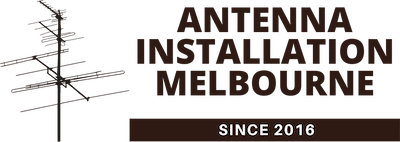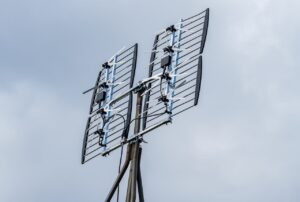How to Install a TV Antenna DIY
What antenna do you need? Where should you mount it? Which brand should you buy? And other details that are involved in getting a good antenna and reception.
What antenna hardware is required to receive TV?
- TV Antenna
- TV Antenna mount
- Cables
- Plugs, fittings & connectors
What brand antenna should I purchase?
What’s the first thing you do? The antenna should be installed at the top. Many TV antennae are available on the market, and they all work well. However, you only get what you pay. Matchmaster is the most popular and longest-lasting brand. In our opinion, this is where I would start and end.
What channels can I expect to receive?
An antenna designed for Australia will receive the required frequencies (channels), which are available in your area. The terrain and distance from the transmitter will also influence which channels you receive. The strength of the signals.
How to overcome bad TV reception
This is a long subject, and I will try to share some knowledge on this topic. You can install an antenna outside and point it in the right direction. There are also areas where the TV signal is affected by landforms and obstructions. The UHF band is the most common for transmitting TV signals, so it depends on what’s called LOS (line-of-sight). It is no longer necessary to place a TV antenna a million metres into the air. This method, which involves placing the antenna high in the sky (especially where there are trees), can cause the signal to fluctuate. You will experience pixelation below this threshold. It will begin with clicking and popping and ruin the entire experience.
What do you do now? You will be more successful if you lower the antenna below the canopy. It can be a little tricky here. When it comes to installing the antenna correctly, most DIYers are blind. Field strength meter is used to determine the correct installation position. This device measures the strength of each station, and then displays this data on a screen.
The best place to mount your antenna
You need to know the location of your antenna to determine what mount you should buy. It is best to hire a local installer to help you mount your TV Antenna. You can do this by yourself if you are confident. Read on …. Call your local installer and then! 🙂
A good MER (Modulation Error ratio) is what we need to get a strong signal. This is the measure of signal quality, taking into consideration all the interference effects that occur on the transmission channel. The picture quality can be affected by moving your antenna 500mm up, down, left or right when mounting it. The MER should be at least 25. A MER over 31 is excellent. Confused? Confused?
We will assume that we have now achieved a reasonable MER for each station. The best TV signals are between 55 and 70 DB microvolts. The lowest levels are 40 -43 DB microvolts. You should aim to achieve this minimum. If everything else fails, 36 is the minimum. This is considered very low if you have no other options. It will work if you have 2 or 4 TVs, but we’re back to the signal issue. Signal boosting is needed! The MASSTHEAD AMPLIFIER is used to achieve this. These devices are designed to boost the signal to a level where all TVs can operate.
How to mount a TV antenna
TV Antenna Mount
For mounting, the standard height is between 1.05 and 1.2 meters.
Most common types of roof mounts are a tile mount or a tripod. They are strong, simple and effective. Mount them as close as possible to the top of your roof on the rear of your house. This will make it look less unattractive and not be visible. It’s nice to get it lower, so that it isn’t visible. You can mount your antenna to a faciaboard using a ‘J bracket.’ Be aware that not all J-mounts are the same. The antenna company sells full galvanised 90 degree bend units of 1.2mm thickness, not tin. It is better to go with fully galvanised.
It can be difficult to get good results if you live behind a mountain, but it is not impossible. The TV signal is strange when it comes down to hills. It will fly up the hill and then drop into the valley. I’ve found that a signal can be received 4 feet off the ground, even in an area where 60ft masts are erected. It is possible to use a trick to receive a signal. It’s called stacking. We use two or four antennas connected together to get more gain. It’s a difficult process that would require a personal discussion with the person to understand. However, it is possible. Four identical antennas with the exact same length cables must be used through a diplexer or quadplexer in order to combine all the cables into one feed.
Boosters are a good example. You may need to use two depending on how long the cable runs. Good quality boosters will allow you to daisy-chain to maintain the level. This allows you to cover hundreds of metres, which is great if you want to mount your antenna on top a hill.
Remember that installing a TV antenna requires specialist equipment such as ladders and safety gear to work at height. You may only need to install an antenna once in your life, so it’s best to leave the job up to a professional.
Servicing
An antenna of good quality, like the Matchmaster, requires little maintenance over its lifetime. The Matchmaster range, made in Australia, comes with a warranty for life! That’s pretty impressive. Matchmaster has some products that are also made in China, but are built to our specifications and are incredibly well built.
How can I find an installer who is reliable in my locality?
Good question. This is a “needle in a haystack” scenario. The TV Antenna Industry is still unlicensed, so anyone with a ladder, some tools, and a claim to be a TV Antenna Installer can do it. There are cowboys everywhere, and this industry is no exception.
What you need to check:
- Check their online presence. Are there any reviews that reflect a competent service?
- Do they greet you with good morning or afternoon when you call Smith Antenna Service?
- Move on if they don’t have an online presence, or answer their phone as if they are just getting out of bed. As they wear multiple hats, many “jacks of all trades” answer with a simple “hello”.
- Two things can happen if you accept a quote for free. It can be a way to get your foot in the door, so to speak. Once on your property, a pushy technician or installer can make you feel obligated no matter what price. It happens a lot and you pay way more than what should be. In many cases, the fix is a simple one, such as a realignment or re-termination. At worst, you may need a new booster or an antenna.
- Ask for an hourly rate up front. Professional companies, such as the Antenna Company (shameless plug:), will tell you their hourly and call-out rate upfront.
Professionals who have the necessary tools and stock are always ready to go and can find the problem and fix it with minimum fuss. The company A might charge $45 an hour, but double that for antennas. Or Company B may charge $85 per hour but use a trade-in price for parts. Some companies charge for everything.
You can see that installing an antenna is not a simple task. The above information should help you to get your antenna in order or clarify what to look out for when looking for an antenna installation service in Melbourne.


